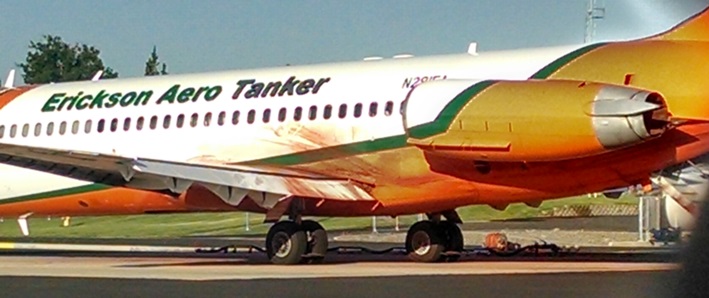
All three of Erickson Aero Tanker’s MD-87s have been “recalled” — pulled out of service “due to intermittent engine surges when dropping [retardant at] high coverage levels”. John Kent Hamilton, the Aviation Safety Manager for the U.S. Forest Service Rocky Mountain Region, said the company believes they have a fix for the problem.
Erickson has developed and flight tested a new spade profile that has proved to eliminate this problem by keeping the fluid column much more vertical. They are in the final engineering approval stages and should be able to install with full approval early next week.
Since we ran a photo on January 6 of an MD-87 dropping water in an early test of the retardant system, there have questions raised on our site about retardant being ingested into the engines. That possibility gained further traction on June 9 with a photo of a parked MD-87 with what appeared to be retardant residue above the wing in front of an engine.
When we asked Kevin McCullough, the President of Erickson Aero Tanker, on June 9 if there were any problems with the MD-87s ingesting retardant into the engines, he said there were none.
The first two MD-87s, Tankers 101 and 105, began working June 4 and June 8, respectively. Soon thereafter, a third one, Tanker 103, reported for duty.
A few days after the MD-87s began dropping retardant on fires, a retardant leak inside the aircraft required that they be returned to their home base for repairs.
The last time we can remember an air tanker model being recalled was February 8, 2012 when the Federal Aviation Administration issued an Emergency Airworthiness Directive that required inspections of P2V aircraft after a 24-inch crack was found in a wing spar and skin on one of Neptune Aviation’s P2V-7 air tankers. This grounded the entire fleet of federal air tankers until all 11 of them were cleared the next day. Today we have a mix of five aircraft models, all with different retardant systems, reducing the chance that all of them will be shut down at the same time due to a defect.

Are they back on line yet ?
On a calm day with little wind on a stable approach and drop over flat ground, retardant leaves the aircraft in a different manner than what one may encounter in wind in terrain, with rotors, downdrafts, updrafts, wind shear, etc. Retardant patterns on the aircraft following a drop can vary considerably; it doesn’t always go the same, and I’ve seen it far up on the airplane in a number of different tankers, before.
Hopefully they’re able to sort out the issue soon, and with some degree of certainty.
Here is an interesting shot. Note the spray coming over the wing. https://www.flickr.com/photos/bd126/12020072935/in/set-72157639914036794/lightbox/
Just curious, in Vietnam they used to do wash the turbine engines weekly on our AH1G Cobras with water and walnut shells to clean them out. Is this procedure still being done? Would it help under this situation?
In the pic of the MD87 you can see what appears to be red residue in the engine exhaust. Do hope they work it out and as mentioned NEW equipment and ideas sometimes take a little time and tweaking before they’re fully operational!
A good example of how to waste of money on new technology would be the F35, but I don’t think anyone will be spending that kind of $$$ on Fire Fighting Air Tanker technology!
Still waiting to see the results of “non-ingestion” on the hot sections of the engines.
I am glad that the issues are being addressed voluntarily and proactively before something catastrophic happened.
Engines “surging” during drops is a hazard both to the aircrew and the troops on the ground.
With the MDs being unavailable I’m wondering where Coulson stands? I’ve been told their airplane is unavailable as well. ?
We checked, and found out that the C-130Q was down for a few days while they performed some maintenance on the landing gear. It was back in the air Sunday and made two drops working out of Albuquerque along with 2 SEATS, 3 P2V’s and two BAE-146s.
When one deals with new tank designs it takes time to work out the bugs. The only way to perfect a design is through time and use. All of these designs are new ideas. In the past most tanks were redesigns of the original Rosenbaum tank. This was a cheap and proven tank that with a few mods could be STCed for any company. The DC-10 tanks from EAC is a good example of using older, but proven, technology
I hope the USFS lets the operators run with their ideas and perfect their examples of the future tanks. I also hope no one is hurt in the process.